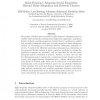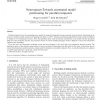245 search results - page 24 / 49 » Mathematical and Computational Modeling of Neurons and Neuro... |
IWANN
2005
Springer
14 years 1 months ago
2005
Springer
Carbon nanotubes are often seen as the only alternative technology to silicon transistors. While they are the most likely short-term alternative, other longer-term alternatives sho...
NIPS
2007
13 years 9 months ago
2007
Stimulus selectivity of sensory neurons is often characterized by estimating their receptive field properties such as orientation selectivity. Receptive fields are usually deriv...
NECO
2007
13 years 7 months ago
2007
We propose a Markov process model for spike-frequency adapting neural ensembles which synthesizes existing mean-adaptation approaches, population density methods, and inhomogeneou...
NIPS
2003
13 years 9 months ago
2003
The relative depth of objects causes small shifts in the left and right retinal positions of these objects, called binocular disparity. Here, we describe a neuromorphic implementa...
IJON
2007
13 years 7 months ago
2007
Parallel computers have the computing power needed to simulate biologically accurate neuronal network models. Partitioning is the process of cutting a model in pieces and assignin...


